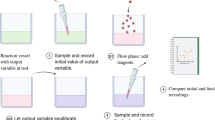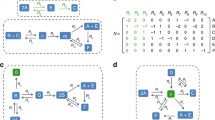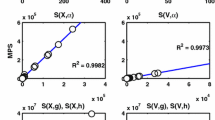Abstract
The main goal of systems biology is to understand the dynamical properties of biological systems by investigating the interactions among the components of a biological system. In this work, we focus on the robustness property, a behaviour observed in several biological systems that allows them to preserve their functions despite external and internal perturbations. We first propose a new formal definition of robustness using the formalism of continuous Petri nets. In particular, we focus on robustness against perturbations to the initial concentrations of species. Then, we demonstrate the validity of our definition by applying it to the models of three different robust biochemical networks.
Access this chapter
Tax calculation will be finalised at checkout
Purchases are for personal use only
Similar content being viewed by others
References
Uri, A.: An Introduction to Systems Biology: Design Principles of Biological Circuits. CRC Press, Boca Raton (2006)
Alur, R., Courcoubetis, C., Henzinger, T.A., Ho, P.-H.: Hybrid automata: an algorithmic approach to the specification and verification of hybrid systems. In: Grossman, R.L., Nerode, A., Ravn, A.P., Rischel, H. (eds.) HS 1991-1992. LNCS, vol. 736, pp. 209–229. Springer, Heidelberg (1993). https://doi.org/10.1007/3-540-57318-6_30
Angeli, D., De Leenheer, P., Sontag, E.D.: On the structural monotonicity of chemical reaction networks, pp. 7–12. IEEE (2006)
Antoniotti, M., Mishra, B., Piazza, C., Policriti, A., Simeoni, M.: Modeling cellular behavior with hybrid automata: bisimulation and collapsing. In: Priami, C. (ed.) CMSB 2003. LNCS, vol. 2602, pp. 57–74. Springer, Heidelberg (2003). https://doi.org/10.1007/3-540-36481-1_6
Barbuti, R., Gori, R., Levi, F., Milazzo, P.: Specialized predictor for reaction systems with context properties. In: International Workshop on Concurrency, Specification and Programming, CS&P 2015, pp. 31–43 (2015)
Barbuti, R., Gori, R., Levi, F., Milazzo, P.: Investigating dynamic causalities in reaction systems. Theoret. Comput. Sci. 623, 114–145 (2016)
Barbuti, R., Gori, R., Levi, F., Milazzo, P.: Specialized predictor for reaction systems with context properties. Fundamenta Informaticae 147(2–3), 173–191 (2016)
Barkai, N., Leibler, S.: Robustness in simple biochemical networks. Nature 387(6636), 913 (1997)
Batchelor, E., Goulian, M.: Robustness and the cycle of phosphorylation and dephosphorylation in a two-component regulatory system. Proc. Nat. Acad. Sci. U.S.A. 100(2), 691–696 (2003)
Chabrier, N., Fages, F.: Symbolic model checking of biochemical networks. In: Priami, C. (ed.) CMSB 2003. LNCS, vol. 2602, pp. 149–162. Springer, Heidelberg (2003). https://doi.org/10.1007/3-540-36481-1_13
Ciocchetta, F., Hillston, J.: Bio-PEPA: a framework for the modelling and analysis of biological systems. Theoret. Comput. Sci. 410(33–34), 3065–3084 (2009)
Danos, V., Feret, J., Fontana, W., Krivine, J.: Abstract interpretation of cellular signalling networks. In: Logozzo, F., Peled, D.A., Zuck, L.D. (eds.) VMCAI 2008. LNCS, vol. 4905, pp. 83–97. Springer, Heidelberg (2008). https://doi.org/10.1007/978-3-540-78163-9_11
Ehrenfeucht, A., Rozenberg, G.: Reaction systems. Fundamenta Informaticae 75(1–4), 263–280 (2007)
Eker, S., Knapp, M., Laderoute, K., Lincoln, P., Meseguer, J., Sonmez, K.: Pathway logic: symbolic analysis of biological signaling. In: Biocomputing 2002, pp. 400–412. World Scientific (2001)
Fages, F., Soliman, S.: Abstract interpretation and types for systems biology. Theoret. Comput. Sci. 403(1), 52–70 (2008)
Feinberg, M.: Chemical reaction network structure and the stability of complex isothermal reactors-I. the deficiency zero and deficiency one theorems. Chem. Eng. Sci. 42(10), 2229–2268 (1987)
Gilbert, D., Heiner, M.: From petri nets to differential equations – an integrative approach for biochemical network analysis. In: Donatelli, S., Thiagarajan, P.S. (eds.) ICATPN 2006. LNCS, vol. 4024, pp. 181–200. Springer, Heidelberg (2006). https://doi.org/10.1007/11767589_11
Gori, R., Levi, F.: Abstract interpretation based verification of temporal properties for bioambients. Inf. Comput. 208(8), 869–921 (2010)
Goss, P.J.E., Peccoud, J.: Quantitative modeling of stochastic systems in molecular biology by using stochastic petri nets. Proc. Nat. Acad. Sci. U.S.A. 95(12), 6750–6755 (1998)
Henzinger, T.A.: The theory of hybrid automata. In: Inan, M.K., Kurshan, R.P. (eds.) Verification of Digital and Hybrid Systems, pp. 265–292. Springer, Heidelberg (2000). https://doi.org/10.1007/978-3-642-59615-5_13
Kitano, H.: Systems biology: towards systems-level understanding of biological systems. In: Kitano, H. (ed.) Foundations of Systems Biology (2002)
Kitano, H.: Biological robustness. Nat. Rev. Genet. 5(11), 826–837 (2004)
Kwiatkowska, M., Norman, G., Parker, D.: Using probabilistic model checking in systems biology. ACM SIGMETRICS Perform. Eval. Rev. 35(4), 14–21 (2008)
Li, X., Omotere, O., Qian, L., Dougherty, E.R.: Review of stochastic hybrid systems with applications in biological systems modeling and analysis. EURASIP J. Bioinf. Syst. Biol. 2017(1), 8 (2017)
Linz, P.: Analytical and Numerical Methods for Volterra Equations. SIAM (1985)
Lotka, A.J.: Contribution to the theory of periodic reactions. J. Phys. Chem. 14(3), 271–274 (1910)
Nasti, L., Milazzo, P.: A computational model of internet addiction phenomena in social networks. In: Cerone, A., Roveri, M. (eds.) SEFM 2017. LNCS, vol. 10729, pp. 86–100. Springer, Cham (2018). https://doi.org/10.1007/978-3-319-74781-1_7
Paun, G.: Introduction to Membrane Computing. Springer, Heidelberg (2006). https://doi.org/10.1007/978-3-642-56196-2
Pérez-Jiménez, M.J., Romero-Campero, F.J.: A study of the robustness of the EGFR signalling cascade using continuous membrane systems. In: Mira, J., Álvarez, J.R. (eds.) IWINAC 2005. LNCS, vol. 3561, pp. 268–278. Springer, Heidelberg (2005). https://doi.org/10.1007/11499220_28
Ramsey, S., Orrell, D., Bolouri, H.: Dizzy: stochastic simulation of large-scale genetic regulatory networks. J. Bioinf. Comput. Biol. 3(02), 415–436 (2005)
Reddy, V.N., Mavrovouniotis, M.L., Liebman, M.N., et al.: Petri net representations in metabolic pathways. In: ISMB, pp. 328–336 (1993)
Rizk, A., Batt, G., Fages, F., Soliman, S.: A general computational method for robustness analysis with applications to synthetic gene networks. Bioinformatics 25(12), i169–i178 (2009)
Rizk, A., Batt, G., Fages, F., Soliman, S.: Continuous valuations of temporal logic specifications with applications to parameter optimization and robustness measures. Theoret. Comput. Sci. 412(26), 2827–2839 (2011)
Shinar, G., Feinberg, M.: Structural sources of robustness in biochemical reaction networks. Science 327(5971), 1389–1391 (2010)
Shinar, G., Feinberg, M.: Design principles for robust biochemical reaction networks: what works, what cannot work, and what might almost work. Mathe. Biosci. 231(1), 39–48 (2011)
Weisstein, E.W.: Logistic equation. From MathWorld-A Wolfram Web Resource. http://mathworld.wolfram.com/LogisticEquation.html
Acknowledgements
This work has been supported by the project “Metodologie informatiche avanzate per l’analisi di dati biomedici” funded by the University of Pisa (PRA_2017_44).
Author information
Authors and Affiliations
Corresponding author
Editor information
Editors and Affiliations
Rights and permissions
Copyright information
© 2018 Springer Nature Switzerland AG
About this paper
Cite this paper
Nasti, L., Gori, R., Milazzo, P. (2018). Formalizing a Notion of Concentration Robustness for Biochemical Networks. In: Mazzara, M., Ober, I., Salaün, G. (eds) Software Technologies: Applications and Foundations. STAF 2018. Lecture Notes in Computer Science(), vol 11176. Springer, Cham. https://doi.org/10.1007/978-3-030-04771-9_8
Download citation
DOI: https://doi.org/10.1007/978-3-030-04771-9_8
Published:
Publisher Name: Springer, Cham
Print ISBN: 978-3-030-04770-2
Online ISBN: 978-3-030-04771-9
eBook Packages: Computer ScienceComputer Science (R0)




